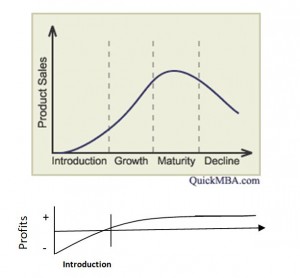Dr. Eric Reidenbach has been a favorite author, mentor and collaborator with me through recent years. We developed the info-program Driving Market Share where we spent a great deal of time discussing his favorite past time, the subject of value. He has given me the honor of posting his latest article. I have taken the liberty of dividing it into two sections with the first half, Capitalize on the Speed of Value to Insure New Product Success below and the second half, Building Value into the NPD Process will be posted tomorrow.
About Dr. Eric Reidenbach. He is the Director of the Six Sigma Marketing Institute and the author of over 20 books on marketing and market research. Dr. Reidenbach has developed a number of unique approaches for measuring and managing value, the best leading indicator of market share growth. His consulting services are absolutely unique. They are filled with proprietary measurement and management techniques designed to help you grow market share and top line revenues. His most recent books include:
- Best in Market: The new Imperative for U.S. Manufacturing (Immediate Download)
- Listening to the Voice of the Market: How to Increase Market Share and Satisfy Current Customers
- Six Sigma Marketing: From Cutting Costs to Growing Market Share
- Value-Driven Channel Strategy: Extending the Lean Approach
Capitalize on the Speed of Value to Insure New Product Success
Much of the focus in new product development is on the degree of acceptance or penetration of the new product into the targeted markets. The objective is the acquisition of market share. Certainly, the successful penetration of targeted product/markets is critical if the new product is to be viable. However, there is another factor to consider – the rate and speed of penetration.
How quickly a new product moves through the introductory stage of its life cycle and begins the payback of heavy developmental and promotional costs are critically important. Languishing in the introductory stage creates an additional financial burden on the viability of the new product. This is where the “spe ed of value” comes into play. The “speed of value” refers to the degree to which targeted buyers can discern and perceive the inherent value of a new product. The greater the visibility and understanding of value, the more rapidly the product will be tried and adopted, and the more quickly it moves through this critical phase of its life cycle.
ed of value” comes into play. The “speed of value” refers to the degree to which targeted buyers can discern and perceive the inherent value of a new product. The greater the visibility and understanding of value, the more rapidly the product will be tried and adopted, and the more quickly it moves through this critical phase of its life cycle.
The Product Lifecycle and Value
The product life cycle is typically portrayed as being composed of 4 stages: introductory, growth, maturity and decline. As the product moves through each stage there are generalizations regarding its behavior suggesting subsequent strategic and tactical options. One such generalization focuses on the low profitability of the new product during its introductory stage. Here sales are low due in large part to the low level of awareness of the new product. This low revenue flow is slow to offset the often heavy costs of development and initial deployment resulting in a slow payback period. It is here that the speed of value is critical. The more discernible and palpable the value there is the shorter the payback period due to an increased rate of sales.
Value Drives Adoption
The product life cycle is tightly linked to what marketers call the consumer adoption process. The adoption process describes the different stages that an individual goes through in his/her decision to adopt a product. Typically the stages include:
Awareness
Interest
Evaluation
Trial
Adoption
These stages take on new and relevant meaning when viewed from a value perspective. In the awareness stage, targeted buyers become aware of the new product – their first glimpse at the potential value of the product. Value awareness is the focus of this stage. The second stage is where the buyer develops some interest regarding the new product. Value is a key element that drives this stage. There is diminished likelihood that the adoption process will continue if the buyer sees little or no value. In the evaluation stage the buyer performs a more rigorous evaluation of the product’s value proposition. Here the key question becomes “Is the product worth it?” The interest and evaluation stages are the value testing stages of the adoption process. Trial involves the buyer actually trying the product. Trial can be either physical or cognitive. In either case, this stage is the first stage in the value confirmation process. Assuming that the product passes initial value confirmation, the probability that the buyer will actually adopt the product is increased. During the adoption stage the buyer subjects the product to a long term value confirmation process. Repurchase and loyalty are subject to whether or not value is confirmed over time. The greater the inherent value in the product, the faster the individual adoption process.
Value Failures
Consider some of the more notorious new product failures – New Coke, the DeLorean, the Chevy Volt and you will see a common factor – the lack of value. Targeted buyers ask a fundamental question “Is the new product worth it?” Failure to pass the “worth it” question increases the probability of failure. Equally important, the more the buyer has to dig to discover value, the slower will be its adoption and acceptance.
On its surface, the “speed of value” seems axiomatic, yet many new product development efforts fail to imbed value into their developmental efforts. This value failure may take a couple of forms. First, it’s fairly common for companies to impose their own sense of value into the process. This occurs when companies are overly product focused and not market focused. In this case, value becomes an abstract concept – removed from the reality of the market and how the market defines value. Falling in love with a new product idea and concept begins the self delusional process of seeing value where value does not exist. Secondly, companies fail to understand the power of value in the adoption and subsequent competitive dynamics of the market place and tend to ignore it or overlook it. A number of researchers and writers (Gale 1996; Reidenbach 2005; Reidenbach 2006) have shown that value is the best leading indicator of market share. Brands that enjoy a superior value proposition are the most likely to be market dominators and top line growth drivers. And, in a hyper competitive world, the speed with which they can become market leaders is crucial.
The rest of the article will be posted tomorrow: Building Value into the New Product Development Process

Comments are closed.